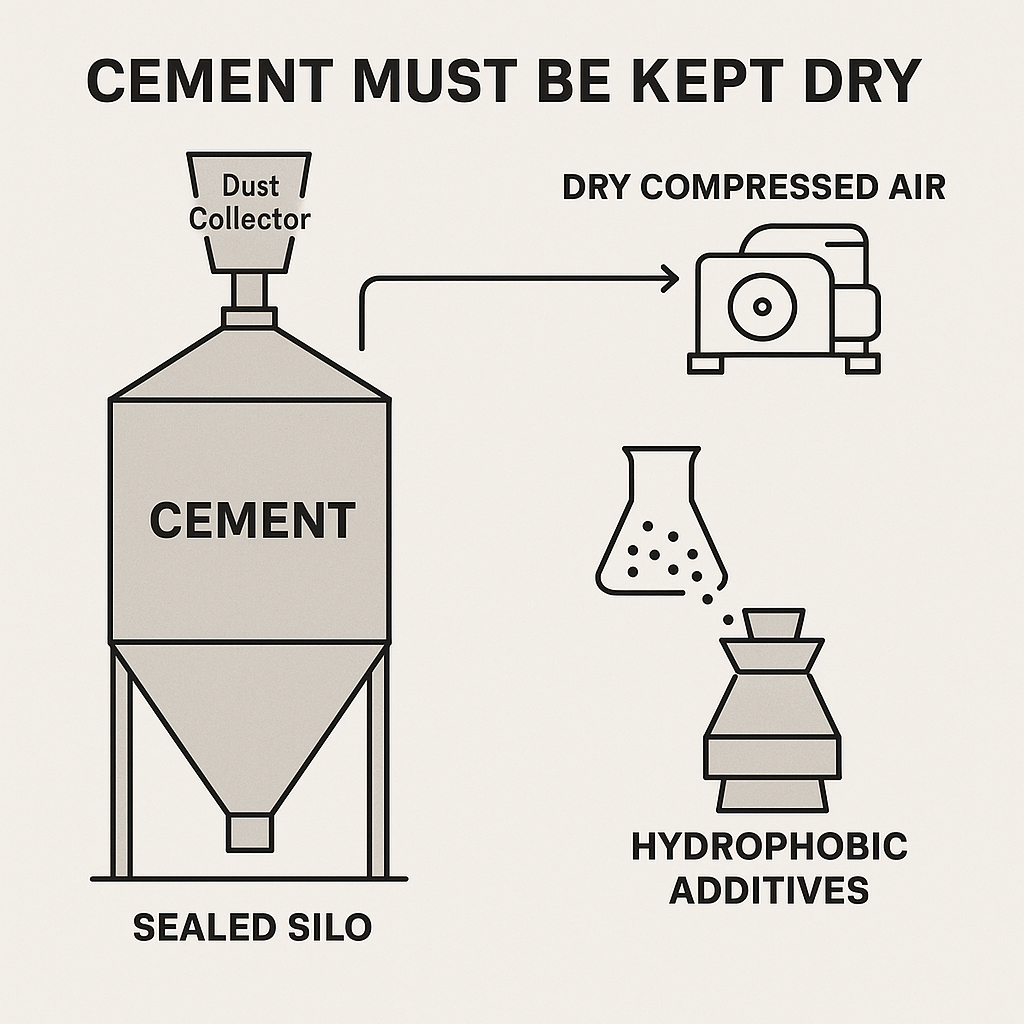Cement starts to misbehave at surprisingly low humidity, with incipient hydration kicking in around RH 60–70% and hardening storage piles. Plants are fighting back with water‑tight silos, low‑dewpoint conveying air, and interground additives that keep powders flowing.
Industry: Cement | Process: Packaging
Moisture is the primary enemy of bagged and bulk cement. Even modest relative humidity (RH 60–70%) can trigger incipient hydration (early surface reaction of cement grains) and rapid hardening in storage, as industry sources emphasize (portlandclinker.com). Field guidance reflects that reality: the usable shelf‑life should be limited to roughly three months if storage truly excludes humidity (dailytrust.com).
That is why best practice treats a silo or warehouse as a sealed vessel—elevated well above flood level, ventilated only through filtered, moisture‑controlled paths that equalize pressure without admitting damp air (portlandclinker.com). On sites handling bags, recommendations get specific: stack on pallets 150–200 mm off the floor, cap with thick plastic sheeting (e.g., 700‑gauge polyethylene), and use “air‑tight” PP/RLDPE plastic sacks (PP, polypropylene; RLDPE, a plastic liner) to minimize exposure (ultratechcement.com).
Ignore sealing and the product bites back. Even the smallest leaks in silo roofs or walls damage stored cement and create material flow issues (askmrsilo.com). Over‑stack bags (often ~10 high is used as a practical limit) or expose them to damp, and lumping accelerates; a moisture content of about 5% is enough to render cement unusable (fepy.com).
Sealed storage and barrier packaging
Modern packaging is evolving to match the risk profile. Multi‑layer moisture‑barrier bags—laminated kraft paper or BOPP‑coated (biaxially oriented polypropylene) PP‑woven sacks, often with polyethylene liners—dramatically reduce moisture ingress and extend shelf life, a trend especially visible in humid markets (portlandclinker.com). In storage, the silo itself is treated as a water‑tight container: vented only through filtered dust collectors to manage fill‑time pressure without admitting moisture (griffinfilters.com). Where vents require particulate control, plants may specify stages such as cartridge filters to remove 1–100 micron particles (particulate size range noted in product scope).
For bagged cement at depots and jobsites, the same logic applies: keep bags on pallets (150–200 mm off the floor), cover with polythene, and minimize atmospheric exposure by using air‑tight plastic sacks—steps reiterated in building guides (ultratechcement.com).
Dry, conditioned air in conveying
Moisture control does not stop at the silo wall. Pneumatic conveying—the dilute‑phase movement of powder suspended in air—typically uses low‑pressure blowers (Roots or screw blowers at less than 4 bar) in cement plants (atlascopco.com). If the carrier air contains moisture, condensation and clogging follow; to prevent this, dehumidification systems are often used so the air is cool and dry (bulksolids-portal.com).
System designers therefore push for low‑dewpoint air (dew point is the temperature at which vapor condenses), typically by applying desiccant dryers or refrigerated dryers, both for conveying and for any silo aeration or “fluidization.” Engineering notes from AZO describe blanket‑air purges and desiccant dryers supplying “extremely dry process air,” because pressure swings and temperature changes otherwise drive atmospheric moisture into the powder (azo-inc.com; azo-inc.com). Untreated ambient air, or over‑aerating a silo, effectively pumps moisture into the vessel and can hydrate the cement (askmrsilo.com).
Best practice is to dry blower or compressed air so its dew point sits well below ambient—often by 30–40 °C—ensuring lines, filters, and silos never see condensation (bulksolids-portal.com). Plants also apply low‑flow, continuous dry‑air purging of silo headspace to prevent moisture migration into settled cement (azo-inc.com).
Grinding‑stage additives and flowability

Chemical additives added during grinding can reduce moisture sensitivity while boosting throughput. Traditional grinding aids—glycols, triethanolamine (TEA), tri‑isopropanolamine (TIPA), sucrose derivatives—primarily disperse fines and can increase mill production by up to about 25%, in part by preventing particle agglomeration (zaf.sika.com). By lowering fine‑powder cohesion, finished cement becomes less prone to arching or rat‑holing in silos. Plants that meter such formulations typically rely on accurate chemical dosing hardware such as dosing pumps to control addition rates.
Specialized hydrophobic additives interground with cement also slow moisture uptake. GCP Applied Technologies’ HYDROPHOBE series—based on long‑chain carboxylic acids, polyalcohols, and similar chemistries—aims to impart water repellency and workability, including air entrainment benefits in use (gcpat.com; gcpat.com). Packaging specialists also report blending small amounts of silicone oils, stearate esters, or other anti‑caking agents directly into the powder to create an internal moisture barrier that complements external bag protection—what they call a dual layer of protection (portlandclinker.com). In practice, interground hydrophobic additives have been shown to delay hydration onset in high humidity, preserving flowability; masonry cement mixes with hydrophobic admixtures now regularly meet ASTM binding requirements while maintaining powder free‑flow at RH > 80%.
Observed outcomes and rejection thresholds
Taken together—airtight silos and bags, conditioned dry air, and hydrophobic chemistry—these measures reduce rejects and unplanned downtime. Plants generally reject cement with more than 5% moisture content (fepy.com), while well‑maintained dry storage retains full strength for months. In monsoonal tropics, moving from ordinary paper to BOPP‑laminated multiwall sacks has been reported to cut moisture ingress by over 80%. Operations that added desiccant air dryers also report pneumatic line blockage rates dropping nearly to zero—outcomes echoed in vendor and engineering notes (askmrsilo.com; azo-inc.com).
Sources: Industry technical datasheets and engineering reports (ultratechcement.com) (askmrsilo.com) (portlandclinker.com) (portlandclinker.com) (azo-inc.com) (azo-inc.com) (gcpat.com) (gcpat.com) (zaf.sika.com) (dailytrust.com), supplemented by manufacturer and journal articles (fepy.com) (bulksolids-portal.com).
